Each year bookstore bookshelves are filled with the latest and greatest picture books, and throughout the year many readers try to determine their favorites. Many of the titles contain eye-catching illustrations and deep messages, most that will attract readers of all ages. Some are the creation of perennial favorites, while others provide tantalizing evidence that a new artistic talent has burst on the children’s literature scene. This week’s book reviews of favorite picture books from 2014 from the Children’s Literature and Reading Special Interest Group include ones you may have seen reviewed earlier this year, but these are keepers.
Barnett, Mac. (2014). Sam and Dave Dig a Hole. Illus. by Jon Klassen. Somerville, MA: Candlewick Press.
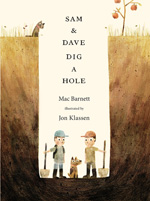 The creators of the marvelous Extra Yarn (Balzer + Bray, 2012) collaborate again to feature two nondescript characters, Sam and Dave, who may remind readers of themselves at play. The two determinedly dig a hole in search of something spectacular. Although Sam and Dave can’t see anything worth finding as they tunnel through the earth, readers can see a large diamond right beneath their shovels. Eventually, they continue their digging path in a meandering fashion that leads them far from the treasure. Exhausted, they fall asleep only to be awakened as they fall through a hole made by the faithful dog that has accompanied them. The ending leaves readers uncertain about what has happened since there are changes to the house to which they return. The digital and colored pencil illustrations will surely have readers guessing about what happened while also having the chance to see what Sam and Dave cannot see throughout the story. The text and illustrations mirror many youthful attempts to dig a hole that reaches all the way to the other side of the world.
The creators of the marvelous Extra Yarn (Balzer + Bray, 2012) collaborate again to feature two nondescript characters, Sam and Dave, who may remind readers of themselves at play. The two determinedly dig a hole in search of something spectacular. Although Sam and Dave can’t see anything worth finding as they tunnel through the earth, readers can see a large diamond right beneath their shovels. Eventually, they continue their digging path in a meandering fashion that leads them far from the treasure. Exhausted, they fall asleep only to be awakened as they fall through a hole made by the faithful dog that has accompanied them. The ending leaves readers uncertain about what has happened since there are changes to the house to which they return. The digital and colored pencil illustrations will surely have readers guessing about what happened while also having the chance to see what Sam and Dave cannot see throughout the story. The text and illustrations mirror many youthful attempts to dig a hole that reaches all the way to the other side of the world.
—Barbara A. Ward, Washington State University Pullman
Barnett, Mac. (2014). Telephone. Illus. by Jen Corace. San Francisco, CA: Chronicle Books.
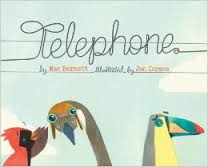 Most children will be familiar with the game of “Gossip” or “Telephone” and how messages are often distorted intentionally or unintentionally. Whether because they are misheard or deliberately misinterpreted, the original message often bears little resemblance to the one the hearer finally hears in a game of "Telephone." In this case, one mother bird’s message to her offspring telling him to fly home for supper passes from one bird to another, getting mangled along the way, until an owl somehow manages to correctly interpret a nonverbal message and put things back on track. Filled with watercolor, ink, gouache, and pencil illustrations drenched in primary colors, this is a terrific picture book to introduce the topics of gossip and character assassination. Maybe the moral here is to deliver your messages yourself if you want to make sure they go through correctly.
Most children will be familiar with the game of “Gossip” or “Telephone” and how messages are often distorted intentionally or unintentionally. Whether because they are misheard or deliberately misinterpreted, the original message often bears little resemblance to the one the hearer finally hears in a game of "Telephone." In this case, one mother bird’s message to her offspring telling him to fly home for supper passes from one bird to another, getting mangled along the way, until an owl somehow manages to correctly interpret a nonverbal message and put things back on track. Filled with watercolor, ink, gouache, and pencil illustrations drenched in primary colors, this is a terrific picture book to introduce the topics of gossip and character assassination. Maybe the moral here is to deliver your messages yourself if you want to make sure they go through correctly.
—Barbara A. Ward, Washington State University Pullman
Bingham, Kelly. (2014). Circle, Square, Moose. Illus. by Paul O. Zelinsky. New York, NY: HarperCollins/Greenwillow Books.
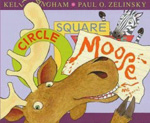 After galloping through the alphabet in all the most inappropriate places, the star of Z Is for Moose (HarperCollins, 2012) goes off on a tear through various shapes, including a square, a triangle, and a circle. As Moose tries desperately to find a place where he fits, inserting himself in this concept book just as he did in its alphabetical predecessor, Zebra comes to his rescue, only to need rescuing himself. The text is amusing, and the bright illustrations play with the interruptions caused by Moose that occur within a most orderly book about shapes. Fans of meta-fictive techniques will enjoy this one just as much as the first one while hoping the author and illustrator decide to do this all again.
After galloping through the alphabet in all the most inappropriate places, the star of Z Is for Moose (HarperCollins, 2012) goes off on a tear through various shapes, including a square, a triangle, and a circle. As Moose tries desperately to find a place where he fits, inserting himself in this concept book just as he did in its alphabetical predecessor, Zebra comes to his rescue, only to need rescuing himself. The text is amusing, and the bright illustrations play with the interruptions caused by Moose that occur within a most orderly book about shapes. Fans of meta-fictive techniques will enjoy this one just as much as the first one while hoping the author and illustrator decide to do this all again.
—Barbara A. Ward, Washington State University Pullman
Brown, Peter. (2014). My Teacher is a Monster! (No, I am Not.) New York, NY: Little, Brown Books for Young Readers.
 Despite what many students believe, teachers are not really monsters, intent on ruining their charges’ lives. They have lives outside of their classrooms, and when you get them by themselves, they can actually be rather fun as this picture book shows. Robert’s teacher, Ms. Kirby, is depicted as rather monstrous with her green skin, fangs, and knotted hair. But a chance encounter in the park allows him to see her differently. The two bond over duck quacking and throwing paper airplanes. Fashioned with India ink, watercolor, gouache, and pencil on paper, the illustrations show how Ms. Kirby has gone from monster to human being in Robert’s eyes. Just as students have their less appealing sides as well as their angelic sides, teachers do as well. Students will enjoy watching Ms. Kirby’s transition and wondering if their own teachers might have a less monstrous side as well. This title is perfect for reading and sharing.
Despite what many students believe, teachers are not really monsters, intent on ruining their charges’ lives. They have lives outside of their classrooms, and when you get them by themselves, they can actually be rather fun as this picture book shows. Robert’s teacher, Ms. Kirby, is depicted as rather monstrous with her green skin, fangs, and knotted hair. But a chance encounter in the park allows him to see her differently. The two bond over duck quacking and throwing paper airplanes. Fashioned with India ink, watercolor, gouache, and pencil on paper, the illustrations show how Ms. Kirby has gone from monster to human being in Robert’s eyes. Just as students have their less appealing sides as well as their angelic sides, teachers do as well. Students will enjoy watching Ms. Kirby’s transition and wondering if their own teachers might have a less monstrous side as well. This title is perfect for reading and sharing.
—Barbara A. Ward, Washington State University Pullman
Bryant, Jen. (2014). The Right Word: Roget and his Thesaurus. Illus. by Melissa Sweet. Grand Rapids, MI: Eerdman’s.
 A must-have title for word lovers, this lively text relates the story of Peter Mark Roget, who created and published a thesaurus that has remained continuously in print since 1852. Writers struggling to find the right word to express their sentiments often turn to a thesaurus for help. Not only has every word in this picture book biography been chosen carefully, but the watercolor, collage, and mixed media illustrations and intricately designed end papers are splendid. Readers will savor this biography of a man relatively unknown in modern times but one who clearly loved words, ideas, and thinking. It’s easy to imagine the young Roget in search of the right word as he wandered the city streets and the countryside with his notes in his pocket.
A must-have title for word lovers, this lively text relates the story of Peter Mark Roget, who created and published a thesaurus that has remained continuously in print since 1852. Writers struggling to find the right word to express their sentiments often turn to a thesaurus for help. Not only has every word in this picture book biography been chosen carefully, but the watercolor, collage, and mixed media illustrations and intricately designed end papers are splendid. Readers will savor this biography of a man relatively unknown in modern times but one who clearly loved words, ideas, and thinking. It’s easy to imagine the young Roget in search of the right word as he wandered the city streets and the countryside with his notes in his pocket.
Essential for classroom libraries, this book is a treasure trove of delight for any budding sesquipedalian.
—Barbara A. Ward, Washington State University Pullman
Cole, Tom Clohosy. (2014). Wall. Somerville, MA: Candlewick/Templar.
 The pages of this book are filled with dark, emotion-laden digital illustrations that capture perfectly life after Berlin was divided into half. This division often separated families as in the case of the narrator who dreams of his own father coming to rescue his family, stuck in East Berlin. When his father doesn’t arrive, he secretly digs a tunnel beneath the land that divides the two sides, and relies on the unexpected kindness of a soldier who allows the narrator, his mother, and his sister to pass unscathed. Despite the fact that the Berlin Wall fell in 1989, the author makes the fear and paranoia of those times after WWII palpable here, making it useful for a social studies class and a discussion of the aftermath of the war. Once again, a picture book makes it clear just how much of an impact political decisions have on the humans who have little control over them.
The pages of this book are filled with dark, emotion-laden digital illustrations that capture perfectly life after Berlin was divided into half. This division often separated families as in the case of the narrator who dreams of his own father coming to rescue his family, stuck in East Berlin. When his father doesn’t arrive, he secretly digs a tunnel beneath the land that divides the two sides, and relies on the unexpected kindness of a soldier who allows the narrator, his mother, and his sister to pass unscathed. Despite the fact that the Berlin Wall fell in 1989, the author makes the fear and paranoia of those times after WWII palpable here, making it useful for a social studies class and a discussion of the aftermath of the war. Once again, a picture book makes it clear just how much of an impact political decisions have on the humans who have little control over them.
—Barbara A. Ward, Washington State University Pullman
Davies, Benji. (2014). The Storm Whale. New York, NY: Simon & Schuster Books for Young Readers.
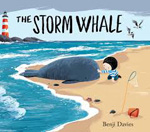 Even six cats aren’t enough to fill the void when Noi’s father leaves him alone while he goes off fishing. Desperate to share his thoughts, he rescues a small whale washed ashore by a fierce storm and shares his stories with the marine mammal. Although he briefly hides the whale from his father, eventually the two of them work together to return it the sea where it belongs. This poignant story reminds readers of the importance of spending time with loved ones and listening to their adventures. Filled with muted colors, the illustrations evoke a sense of the briny sea air and sandy beach where the book is set. The story plucks away at readers’ heart strings long after they've finished reading it.
Even six cats aren’t enough to fill the void when Noi’s father leaves him alone while he goes off fishing. Desperate to share his thoughts, he rescues a small whale washed ashore by a fierce storm and shares his stories with the marine mammal. Although he briefly hides the whale from his father, eventually the two of them work together to return it the sea where it belongs. This poignant story reminds readers of the importance of spending time with loved ones and listening to their adventures. Filled with muted colors, the illustrations evoke a sense of the briny sea air and sandy beach where the book is set. The story plucks away at readers’ heart strings long after they've finished reading it.
—Barbara A. Ward, Washington State University Pullman
Gravett, Emily. (2014). Matilda’s Cat. New York, NY: Simon & Schuster Books for Young Readers.
 There is no doubt that Matilda loves her feline companion, but she has no idea what the cat enjoys. None of the activities that thrill Matilda—playing with wool, fighting with foes or even climbing trees—appeals to her cat. The one thing that this cat loves is Matilda, a bond that makes her cat tolerate her efforts to entertain it. The author's simple text and illustrations, created with oil-based pencil, watercolor, and colored pencils, show the poor cat's ever-heightening anxiety as Matilda's games become increasingly wilder. Even the bedtime story she reads to her cat is frightening since it features Dogs (Simon & Schuster, 2010), an earlier picture book by this same author/illustrator. The book features so many delightful touches: the back cover with the cat scratching the wall, the endpapers, and the look of bliss as the two friends snuggle in bed, content to have found something they have in common.
There is no doubt that Matilda loves her feline companion, but she has no idea what the cat enjoys. None of the activities that thrill Matilda—playing with wool, fighting with foes or even climbing trees—appeals to her cat. The one thing that this cat loves is Matilda, a bond that makes her cat tolerate her efforts to entertain it. The author's simple text and illustrations, created with oil-based pencil, watercolor, and colored pencils, show the poor cat's ever-heightening anxiety as Matilda's games become increasingly wilder. Even the bedtime story she reads to her cat is frightening since it features Dogs (Simon & Schuster, 2010), an earlier picture book by this same author/illustrator. The book features so many delightful touches: the back cover with the cat scratching the wall, the endpapers, and the look of bliss as the two friends snuggle in bed, content to have found something they have in common.
—Barbara A. Ward, Washington State University Pullman
Haughton, Chris. (2014). Sh! We Have a Plan. Somerville, MA: Candlewick.
 Four individuals of different sizes move through the woods at night in search of prey. It quickly becomes clear that they are not out for a stroll but are carrying nets—and have a plan—to capture a bird. Over and over, they fail in capturing their prey, while the smallest member of the party attracts a flock of birds without a net but through his friendliness, kindness, and offer of food. Of course, the others never learn from his example and keep hushing him and insisting that they have a plan. Many young readers will enjoy the story on a surface level while others will see its life lessons about the effectiveness of force or gentleness. The repetitive, cautionary "Shh"s and the moody digital illustrations make readers feel as though they are moving through the night stealthily with a plan or two of their own.
Four individuals of different sizes move through the woods at night in search of prey. It quickly becomes clear that they are not out for a stroll but are carrying nets—and have a plan—to capture a bird. Over and over, they fail in capturing their prey, while the smallest member of the party attracts a flock of birds without a net but through his friendliness, kindness, and offer of food. Of course, the others never learn from his example and keep hushing him and insisting that they have a plan. Many young readers will enjoy the story on a surface level while others will see its life lessons about the effectiveness of force or gentleness. The repetitive, cautionary "Shh"s and the moody digital illustrations make readers feel as though they are moving through the night stealthily with a plan or two of their own.
—Barbara A. Ward, Washington State University Pullman
Hofmeyr, Dianne. (2014). Zeraffa Giraffa. Illus. by Jane Ray. London, United Kingdom: Frances Lincoln Children’s Books.
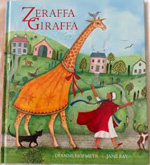 In an attempt to impress the King of France, Muhammad Ali, an Egyptian ruler, sends him an impressive gift, a giraffe. A mere baby when her journey to Paris begins, the giraffe, named Zeraffa, travels first tied to a camel, then on a small ship, next to a large sailing ship, and finally on foot. She and her keeper, a boy named Atir, arrive at their destination in 1827, two and a half years after they set out. The watercolor illustrations show the giraffe's gentle nature and extraordinary colors and eyes and the amazement of the French citizens who were fascinated by Zeraffa’s arrival. Readers will be intrigued by the wonderful protective devices that were devised for Zeraffa, including a fur-trimmed cloak to keep her warm during the winter. It would be hard not to fall in love with this extraordinary creature or the story about her.
In an attempt to impress the King of France, Muhammad Ali, an Egyptian ruler, sends him an impressive gift, a giraffe. A mere baby when her journey to Paris begins, the giraffe, named Zeraffa, travels first tied to a camel, then on a small ship, next to a large sailing ship, and finally on foot. She and her keeper, a boy named Atir, arrive at their destination in 1827, two and a half years after they set out. The watercolor illustrations show the giraffe's gentle nature and extraordinary colors and eyes and the amazement of the French citizens who were fascinated by Zeraffa’s arrival. Readers will be intrigued by the wonderful protective devices that were devised for Zeraffa, including a fur-trimmed cloak to keep her warm during the winter. It would be hard not to fall in love with this extraordinary creature or the story about her.
—Barbara A. Ward, Washington State University Pullman
Jeffers, Oliver. (2014). Once Upon an Alphabet. New York, NY: Philomel.
 It has been said that every picture tells a story, but in this book, the author/illustrator finds a story in every letter of the alphabet. As he brilliantly crafts short—very short—stories for all 26 letters of the alphabet, he even links some of the characters from one story to the next or from one letter (e for enigma and elephant) to another (n for nearly nine thousand) in stylish fashion. Deftly playing with words and concepts, he introduces readers to a problem-solving owl and octopus team while also slipping in some characters familiar to fans of his earlier books. Filled with humor and possibilities, this picture book encourages readers to consider each letter and wonder what might happen next or what happened before the story started. Since this unique ABC book begins and ends with an unlikely astronaut named Edmund who is trying to conquer his fear of heights, readers will feel as though they have been drawn into a story arc that veers into multiple directions. The illustrations consist of drawings created with ink with digitally added spot colors on the letters. Although the book jacket suggests reading the entire book in one gulp or dipping into a letter or story or two at one time, word lovers may want to read it a couple of times in a row and then sharing it with a reading buddy. Because there is so much going on here, it's not intended for beginning readers unless they are intellectually sophisticated.
It has been said that every picture tells a story, but in this book, the author/illustrator finds a story in every letter of the alphabet. As he brilliantly crafts short—very short—stories for all 26 letters of the alphabet, he even links some of the characters from one story to the next or from one letter (e for enigma and elephant) to another (n for nearly nine thousand) in stylish fashion. Deftly playing with words and concepts, he introduces readers to a problem-solving owl and octopus team while also slipping in some characters familiar to fans of his earlier books. Filled with humor and possibilities, this picture book encourages readers to consider each letter and wonder what might happen next or what happened before the story started. Since this unique ABC book begins and ends with an unlikely astronaut named Edmund who is trying to conquer his fear of heights, readers will feel as though they have been drawn into a story arc that veers into multiple directions. The illustrations consist of drawings created with ink with digitally added spot colors on the letters. Although the book jacket suggests reading the entire book in one gulp or dipping into a letter or story or two at one time, word lovers may want to read it a couple of times in a row and then sharing it with a reading buddy. Because there is so much going on here, it's not intended for beginning readers unless they are intellectually sophisticated.
—Barbara A. Ward, Washington State University Pullman
McCarney, Rosemary. (2014). Dear Malala, We Stand With You. New York, NY: Random House/Crown Books for Young Readers.
 This appealing photo essay is essentially a letter of support for social activist Malala Yousafzai from girls from around the globe. Because she chose to attend school, 15-year-old Malala was gunned down in 2012 by the Taliban in Pakistan. The book provides a brief overview of what happened to Malala, and then allows various girls to greet her and express their support and sympathy. It is also a call to action since many of these girls have been inspired to fight for their own education through her example. Shockingly, the book is dedicated to the 65 million girls who are not in either primary or secondary school, a statistic that will make readers think hard about the value of an education. Anyone that takes for granted this nation’s freedoms and those who complain about having to study or complete homework should read this book as a reminder of the life-changing power of an education.
This appealing photo essay is essentially a letter of support for social activist Malala Yousafzai from girls from around the globe. Because she chose to attend school, 15-year-old Malala was gunned down in 2012 by the Taliban in Pakistan. The book provides a brief overview of what happened to Malala, and then allows various girls to greet her and express their support and sympathy. It is also a call to action since many of these girls have been inspired to fight for their own education through her example. Shockingly, the book is dedicated to the 65 million girls who are not in either primary or secondary school, a statistic that will make readers think hard about the value of an education. Anyone that takes for granted this nation’s freedoms and those who complain about having to study or complete homework should read this book as a reminder of the life-changing power of an education.
—Barbara A. Ward, Washington State University Pullman
Macintosh, David. (2014). Lucky. New York, NY: Harry N. Abrams.
 Delighted that their mother has a surprise waiting for them at the end of the day, Leo and his brother try hard to guess what it might be. The narrator's imagination runs wild with all the possibilities, and he blows everything out of proportion, setting up expectations that will be hard to meet. Once the brothers arrive home, there is, indeed, a surprise, but it doesn’t come close to what the boys had imagined. Many young readers will relate to the narrator's disappointment while also being glad for Leo's ability to put a positive spin on everything. Maybe, in the end, there are lots of different ways to be lucky. The illustrations are filled with bright colors and large font sizes that show the boys' rising excitement throughout the story and the narrator's ultimate disappointment.
Delighted that their mother has a surprise waiting for them at the end of the day, Leo and his brother try hard to guess what it might be. The narrator's imagination runs wild with all the possibilities, and he blows everything out of proportion, setting up expectations that will be hard to meet. Once the brothers arrive home, there is, indeed, a surprise, but it doesn’t come close to what the boys had imagined. Many young readers will relate to the narrator's disappointment while also being glad for Leo's ability to put a positive spin on everything. Maybe, in the end, there are lots of different ways to be lucky. The illustrations are filled with bright colors and large font sizes that show the boys' rising excitement throughout the story and the narrator's ultimate disappointment.
—Barbara A. Ward, Washington State University Pullman
Millard, Glenda. Once a Shepherd. Illus. by Phil Lesnie. Somerville, MA: Candlewick.
 Although he loves his idyllic life tending sheep and doesn’t want to leave the peaceful meadows where they graze, Tom Shepherd does his duty and heads off to war. When he doesn't return, his wife and the child he never got to see must somehow find a way to carry on. While nothing can help Cherry, Tom's wife, feel better, her pain is eased when a visitor arrives to provide details of how he died and in imagining a world without conflict, made possible, in part, through Tom’s sacrifice. This picture book provides a way to introduce war's painful losses while also providing some hope for a peaceful future because of those losses. Readers will notice the poetic lines and the repetition of the word "once" in an almost fairy tale fashion, and how the text and the lovely watercolor illustrations contrast scenes of war and peace.
Although he loves his idyllic life tending sheep and doesn’t want to leave the peaceful meadows where they graze, Tom Shepherd does his duty and heads off to war. When he doesn't return, his wife and the child he never got to see must somehow find a way to carry on. While nothing can help Cherry, Tom's wife, feel better, her pain is eased when a visitor arrives to provide details of how he died and in imagining a world without conflict, made possible, in part, through Tom’s sacrifice. This picture book provides a way to introduce war's painful losses while also providing some hope for a peaceful future because of those losses. Readers will notice the poetic lines and the repetition of the word "once" in an almost fairy tale fashion, and how the text and the lovely watercolor illustrations contrast scenes of war and peace.
—Barbara A. Ward, Washington State University Pullman
Morris, Jackie. (2014). Something About a Bear. London, United Kingdom: Frances Lincoln Children’s Books.
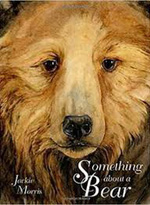 Lovely watercolor illustrations effectively show the differences among various kinds of bears, from the brown bear to the sun bear. Each bear gets its due with information provided about its eating habits, habitat, and characteristics. The animals are the stars here, and the author/illustrator has clearly spent a great deal of time observing them. Back matter includes thumbnail sketches of the bears readers encountered earlier in the book. Even the opening pages are inviting and have a storytelling quality about them: "Let me tell you something--something about a bear" (unpaged). This is an excellent introductory title to include in a science classroom. Readers will surely want to know more about this incredible species depicted through simple text and highly–detailed illustrations.
Lovely watercolor illustrations effectively show the differences among various kinds of bears, from the brown bear to the sun bear. Each bear gets its due with information provided about its eating habits, habitat, and characteristics. The animals are the stars here, and the author/illustrator has clearly spent a great deal of time observing them. Back matter includes thumbnail sketches of the bears readers encountered earlier in the book. Even the opening pages are inviting and have a storytelling quality about them: "Let me tell you something--something about a bear" (unpaged). This is an excellent introductory title to include in a science classroom. Readers will surely want to know more about this incredible species depicted through simple text and highly–detailed illustrations.
—Barbara A. Ward, Washington State University Pullman
O’Connor, George. (2014). If I Had a Raptor. Somerville, MA: Candlewick Press.
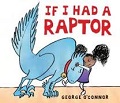 Delighted by how fluffy a baby is, a charming little girl dreams of what it might be like to bring home a baby raptor. Things start off just fine with the raptor playing hide and seek and warming up on the windowsill. But as it gets larger and older, the raptor grows larger and is sure to revert to its natural nature. After all, it is a raptor. Readers will simultaneously smile and shudder at this one, and they certainly will be glad for the presence of that bell hanging around the raptor's neck. Rendered in pencil and watercolor with some additional digital touches, the illustrations delightfully push readers' imaginations. One of the best parts of the book is how much the raptor resembles the more familiar family house cat in its antics.
Delighted by how fluffy a baby is, a charming little girl dreams of what it might be like to bring home a baby raptor. Things start off just fine with the raptor playing hide and seek and warming up on the windowsill. But as it gets larger and older, the raptor grows larger and is sure to revert to its natural nature. After all, it is a raptor. Readers will simultaneously smile and shudder at this one, and they certainly will be glad for the presence of that bell hanging around the raptor's neck. Rendered in pencil and watercolor with some additional digital touches, the illustrations delightfully push readers' imaginations. One of the best parts of the book is how much the raptor resembles the more familiar family house cat in its antics.
—Barbara A. Ward, Washington State University Pullman
Offill, Jenny. (2014). Sparky! Illus. by Chris Appelhans. New York: Random House/Schwartz & Wade.
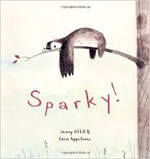 As happens with many youngsters desperate for a pet of their own, the narrator mounts a campaign to persuade her mother to let her have one. After doing research about pets that meet her mother's requirements, her choices are limited, and she ends up with a sloth. The two spend time together, but the sloth's slowness makes it hard for them to share very much. Not surprisingly, even training the sloth to do tricks takes a long, long, long time. There's something appealing about the sloth, though, and even though others may not see the appeal in her pet sloth, the narrator does. The text is wonderfully understated, and the watercolor and pencil illustrations depict the growing bond between a girl and her sloth perfectly. Despite her best intentions, the sloth remains essentially a sloth. Readers will do a second take after reading lines such as this one: "We played Statue and Sparky was very, very good" (unpaged), which is not surprising. This book will brought a smile to reader’s lips as they contemplate this unlikely friendship. There’s just something appealing about Sparky that makes readers root for the two friends.
As happens with many youngsters desperate for a pet of their own, the narrator mounts a campaign to persuade her mother to let her have one. After doing research about pets that meet her mother's requirements, her choices are limited, and she ends up with a sloth. The two spend time together, but the sloth's slowness makes it hard for them to share very much. Not surprisingly, even training the sloth to do tricks takes a long, long, long time. There's something appealing about the sloth, though, and even though others may not see the appeal in her pet sloth, the narrator does. The text is wonderfully understated, and the watercolor and pencil illustrations depict the growing bond between a girl and her sloth perfectly. Despite her best intentions, the sloth remains essentially a sloth. Readers will do a second take after reading lines such as this one: "We played Statue and Sparky was very, very good" (unpaged), which is not surprising. This book will brought a smile to reader’s lips as they contemplate this unlikely friendship. There’s just something appealing about Sparky that makes readers root for the two friends.
—Barbara A. Ward, Washington State University Pullman
Rudge, Leila. (2014). A Perfect Place for Ted. Somerville, MA: Candlewick Press.
 Day after day, Ted watches as the animals in the pet shop where he lives leave with their new human companions. Despite his best efforts, no one ever notices him, and he decides to take matters in his own hands, leaving the pet shop behind and looking for a way to gain the attention of others. As he looks for ways to stand out, he finally catches the attention of Dot who is looking for a furry friend and adopts Ted. The book’s conclusion is simply "puuuurrrrrfect" (unpaged), and the illustrations, created in pencil, ink, and collage, show Ted's feelings perfectly. Those last few pages with the surprised faces of Ted’s new housemates are terrific, capturing how cats behave when something new enters their domain. Ted’s perfect place may not be what he had in mind, but clearly, he is surrounded by much love and furry bodies.
Day after day, Ted watches as the animals in the pet shop where he lives leave with their new human companions. Despite his best efforts, no one ever notices him, and he decides to take matters in his own hands, leaving the pet shop behind and looking for a way to gain the attention of others. As he looks for ways to stand out, he finally catches the attention of Dot who is looking for a furry friend and adopts Ted. The book’s conclusion is simply "puuuurrrrrfect" (unpaged), and the illustrations, created in pencil, ink, and collage, show Ted's feelings perfectly. Those last few pages with the surprised faces of Ted’s new housemates are terrific, capturing how cats behave when something new enters their domain. Ted’s perfect place may not be what he had in mind, but clearly, he is surrounded by much love and furry bodies.
—Barbara A. Ward, Washington State University Pullman
Saltzberg, Barney. (2014). Tea with Grandpa. New York, NY: Macmillan/Roaring Brook Press.
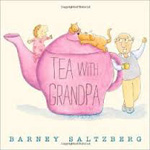 Distance can make it hard to maintain strong relationships with others. But this picture book written in rhyming text shows how one granddaughter and her grandfather keep those family ties strong through the use of technology and a daily ritual that they share across the miles that separate them. While young readers will probably realize from the very first page how the two are managing to share a cup of tea, older readers may not. This is a sweet reminder of how innovations can make it easier to communicate and keep the distance from growing. The illustrations are just as appealing as the sweet story that shows how much love there is between these two family members.
Distance can make it hard to maintain strong relationships with others. But this picture book written in rhyming text shows how one granddaughter and her grandfather keep those family ties strong through the use of technology and a daily ritual that they share across the miles that separate them. While young readers will probably realize from the very first page how the two are managing to share a cup of tea, older readers may not. This is a sweet reminder of how innovations can make it easier to communicate and keep the distance from growing. The illustrations are just as appealing as the sweet story that shows how much love there is between these two family members.
—Barbara A. Ward, Washington State University Pullman
Van Hout, Mies. (2014). Surprise. Holland: Lemniscaat.
 It's pretty amazing how a bird can express so many human emotions so vividly as this lovely picture book shows on every page. The author/illustrator takes an adult bird through all the stages of life, beginning with “yearning” for an offspring all the way through the “letting go” part when the little bird is sent off on its own. Parents and children will enjoy sharing this picture book and discussing how it mimics life. Especially appealing are the illustrations of the mother bird as she listens to her offspring. Many readers will be able to relate to this bird's experiences and the surprises, cloaked in vibrant colors against a dark background that greet readers on every page.
It's pretty amazing how a bird can express so many human emotions so vividly as this lovely picture book shows on every page. The author/illustrator takes an adult bird through all the stages of life, beginning with “yearning” for an offspring all the way through the “letting go” part when the little bird is sent off on its own. Parents and children will enjoy sharing this picture book and discussing how it mimics life. Especially appealing are the illustrations of the mother bird as she listens to her offspring. Many readers will be able to relate to this bird's experiences and the surprises, cloaked in vibrant colors against a dark background that greet readers on every page.
—Barbara A. Ward, Washington State University Pullman
These reviews are submitted by members of the International Reading Association's Children's Literature and Reading Special Interest Group (CL/R SIG) and are published weekly on Reading Today Online.